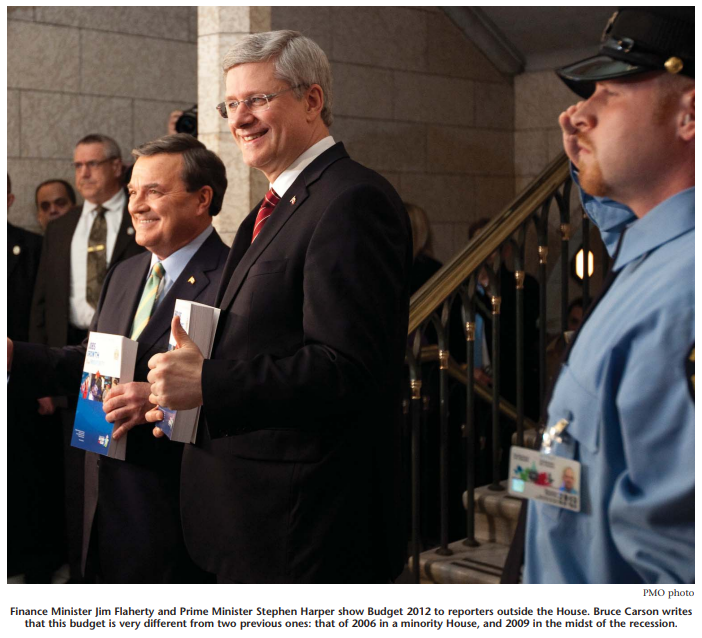
The purpose of this article is to explore the pressures that are experienced by a federal finance minister in the task of putting together the budget. One has to remember that the budget deals with both revenue and spending. It contains projections of revenue growth or otherwise, as well as the items that revenue will be spent on.
When dealing with spending, there are a number of initial constraints that are actually outside the normal pressures. For example, the biggest line item in spending is the interest to be paid annually on the debt. There are also transfers to provinces and persons whose amounts are dictated by statute. These amounts are known and come off the top when dealing with expenditures. Also, before the minister can look at discretionary spending to satisfy certain pressures, there are public service salaries to be paid, unless — as has been done recently with a proposed reduction in the federal workforce — this is a known and ever increasing amount.
So when dealing with pressures, the finance minister has to look at the revenue side first to predict or quantify the revenue coming in. This establishes the fiscal framework within which the spending pressures should operate. Then one looks at the spending side, once all the annual or statutory spending has been subtracted, to respond to the various pressures to spend on new or continuing government priorities.
In recent years, the House of Commons Finance Committee has played a crucial role in the budget. It holds prebudget consultations across the country and writes a report. This report is important in that it lets the minister know the budgetary priorities of the Canadians that met with the committee. In undertaking this work in Budget 2012, the Finance Committee, under Conservative chair James Rajotte, has been most helpful in giving another set of eyes and ears to spending requests and even sometimes making suggestions as to how to raise revenue.
Stakeholders who don’t feel their views are adequately represented in the prebudget committee report or feel they need to press their case directly to the minister are another source of pressure. The Canadian Association of Municipalities, the Canadian Medical Association and similar trade organizations are examples of such stakeholders.
Another pressure that does not always come quickly to mind is the Bank of Canada. One could almost refer to it as a silent pressure. One of the Bank of Canada’s main tasks is to keep inflation within a certain low bandwidth. The Minister of Finance, in designing program spending, reducing spending or pursuing reductions in the public service must always bear in mind the effect of the budget proposals on inflation and therefore their effect on the role of the Bank of Canada.
Then there are members of Parliament and the minister’s cabinet colleagues, all of whom have pet projects, which are crucial for the MP, the MP’s constituents and the country as a whole. I remember, years ago, when I was involved in writing the Huntington-Lachance Report on the budgetary process, Ron Huntington said that he had never met an MP who ever suggested reducing spending in his own constituency.
If, as in 2009, expenditure pressures far exceed revenue, then a decision has to be made as to how big a number that should be and what type of deficit is going to occur — cyclical or structural. The 2009/10 deficit, at $56 billion, was the largest in Canadian history. But it served a stimulative purpose and helped to pull Canada out of the recession.
Of course there is the prime minister, who may have spending pressures of his own, which are not reflected or included in any of the above. And then there is the occasional accident or “train wreck,” like the 2008 fall update, which nearly triggered the fall of the newly reelected government over measures to abolish the public subsidies to political parties and limit the right to strike in the public sector.
Had the government not prorogued the House, it would have fallen on the budget update and been replaced by the opposition coalition. In the event, Finance Minister Jim Flaherty adroitly pivoted and introduced the January 2009 budget that rolled out the stimulus program to deal with the global financial crisis and the Great Recession.
Finally, and perhaps most importantly, there are the government’s policies themselves, which can only be implemented through the budget’s expenditures. We’ve seen that in Budget 2012, which is much more than a fiscal framework, but equally a political document. For example, on energy and the environment, Stephen Harper’s government is shutting down the National Round Table on the Environment and the Economy and streamlining regulatory review of projects such as the Northern Gateway Pipeline, so there is “one project, one review.”
The most obvious pressure here is the amount of anticipated revenue from taxation. Will it exceed the spending pressures and if so, by how much, as that is the surplus, and the question is, how should that surplus be used, if at all? If, as in 2009, expenditure pressures far exceed revenue, then a decision has to be made as to how big a number that should be and what type of deficit is going to occur — cyclical or structural. The 2009/10 deficit, at $56 billion, was the largest in Canadian history. But it served a stimulative purpose and helped to pull Canada out of the recession. Since growth resumed in July 2009, the Canadian economy has created nearly 700,000 jobs, when one includes the postbudget March 2012 job report. Eighty-two thousand new jobs were created that month, bringing unemployment down to just 7.2 percent. The projected current deficit of $21 billion is only 1.2 percent of the GDP, and with a return to budgetary balance and surpluses by 2015, it’s clear Canada’s deficit is cyclical, not structural. But for a while there, as someone said, we were all Keynesians.
Part of the revenue pressure comes from within the country and even from certain parts of the country. This is evident now, with the apparent economic fault line of the Ontario-Manitoba border.
The other revenue pressure is outside Canada. This was experienced in box-car letters in 2009 and to a certain extent in 2012. Canada is a trading nation living very much within the world, not sitting in splendid isolation in the northern part of the North American continent. So revenues are significantly affected by world events.
The task of the finance minister, assisted and supported by the Department of Finance, is to deal with all of these pressures, both on the revenue and spending sides.
In many cases it could be termed a tightrope act, a major balancing act or in some instances a juggling act. The many spending pressures must be sifted through, prioritized and then measured against government policy and/or a major thematic for the budget. Do the spending requests implement an election platform, do they provide “shovel ready” economic stimulus as the 2009 and subsequent stimulative budgets did? Or do they move the federation in the direction desired by the government?
To better illustrate these pressures from the revenue, expenditure and even political vantage points, it is instructive to look at the 2006, 2009 and 2012 budgets.
The political pressure on the new Harper government was that it was in a minority situation and was dependent on opposition support for the budget in order for it to pass through the House of Commons. In the Senate, where the Liberals held a majority, passage depended on Liberal support or significant Liberal absenteeism.
The revenue pressures on the federal government were minimal at that point. A significant budgetary surplus existed. The philosophical difference regarding the accumulation of surplus was now evident under a Conservative government. The new government believed that the surplus should be returned to Canadians through program spending and tax reduction. Included in the government’s five priorities from the campaign were a reduction of the GST from 7 percent to 6 percent, and eventually 5 percent, as well as $100 in child care payments for each preschool child. These campaign commitments were central to the Conservatives’ election, and it was essential that these promises be kept in the first budget.
Moreover, as the government did not believe it was going to last very long, it was vitally important to have as many platform promises as possible reflected in the budget. The budget was the main vehicle for platform policy implementation.
So the pressure that the Finance Minister and ultimately the Prime Minister faced was one of prioritization. How many promises could be implemented in this budget and what could be safely left to the 2007 budget — provided, of course the government was still around to develop a budget?
Ultimately, a number of platform proposals made their way into this budget — the main criteria being that they had to have real impact on the lives of Canadians. Items such as resolving the vertical fiscal imbalance with the provinces were left to the 2007 budget.
The 2009 budget was the so-called stimulus budget. The political pressures had changed from 2006, but the government was still in a minority situation.
The revenue pressures had completely reversed from even the 2008 budget. Revenues were down, owing to the worst synchronized global recession since the end of the Second World War. The decision was made to deal with these revenue pressures by going into deficit, not reduce spending to match the decreasing revenues. The policy decision was made to accommodate the spending pressures by increasing spending and consciously going into deficit.
Once that decision had been made, others had to follow. What kind of spending and how much? The policy lens through which all stimulus spending was viewed was did it put people to work (jobs), was the particular matter ready to move on now (shovel ready) and was it time limited — it needed a defined timeline and had to end.
The watchword was that meeting spending pressures could not come at the cost of creating a structural deficit. Once the money was spent, the goal accomplished, the spending in whatever area it was would cease. There had to be a road map back to balance. This was not a time to increase program spending that would go on forever.
The other crucial matter was to ensure that stimulus funding was spent and spent quickly so that the goals could be accomplished in a short time frame. To be effective, by definition, stimulus spending had to create jobs for Canadians as soon as possible. Due diligence was necessary — but not to the extreme that would kill the intent. On this matter the government was incredibly successful.
Another underlying policy decision that helped with the spending pressure was that the federal government wanted to partner with provinces and municipalities.
Everyone had to have skin in the game on stimulus projects.
Stimulus spending had to create jobs for Canadians as soon as possible. Due diligence was necessary — but not to the extreme that would kill the intent. On this matter the government was incredibly successful.
The most recent federal budget was presented at a time when the political pressures were somewhat relieved. The government is in a majority position in both the House and the Senate.
The revenue pressures still exist, not to the extent they did in 2009, but Canada is still in a deficit position. The policy decision was not to increase revenues through taxation, but to respond to revenue pressures through measures that would stimulate business spending.
Spending pressures were responded to by reducing spending and reducing the federal workforce. The key here was to ensure that cutting did not go so deep as to throw the country back into recession. The operational spending review has resulted in projected spending cuts of $5.2 billion to 2017, or 6.9 percent of the operational spending envelope, and only 1.9 percent overall. The public service will be reduced by 19,000 positions over the period, mostly by attrition. This is hardly revolutionary with regard to taking costs out of the system.
As well, policy decisions were made that dictated spending pressures. The most notable involved innovation, energy through regulatory efficiencies, time-limited environmental review process and economically targeted immigration. There was also a need to respond to the crisis in First Nations education.
Federal-provincial spending pressures were dealt with primarily, as in health care, by giving the provinces access to a stable funding envelope, with health care funding increasing by 6 percent over the next three years, longer than the two years the Conservatives promised in the campaign to extend the terms of the 2004 Health Accord when it expires in 2014.
The overall theme by which pressures both on the revenue and spending side were dealt with was by moving to what I believe is a redefinition of federalism. This new federalism is actually classical because it has its basis in respecting the division of powers between Ottawa and the provinces found in sections 91 and 92 of the Constitution Act, 1867. As well, it means an economy driven by business and industry, not by government. Government’s role is to act as a catalyst and then to get out of the way.
In good times and in bad, the pressures on a federal minister of finance are enormous. The development of a budget that responds positively to these pressures is like developing a fine work of art. One needs the right tools, an eye for colour, patience beyond anything imaginable and the stamina to sort out priorities and then ensure their implementation.
With his seventh budget, Jim Flaherty is now well established in that regard.
Photo: Shutterstock








